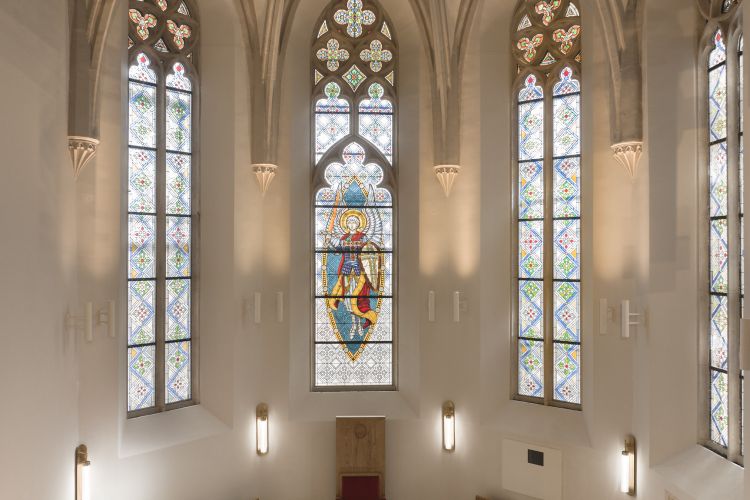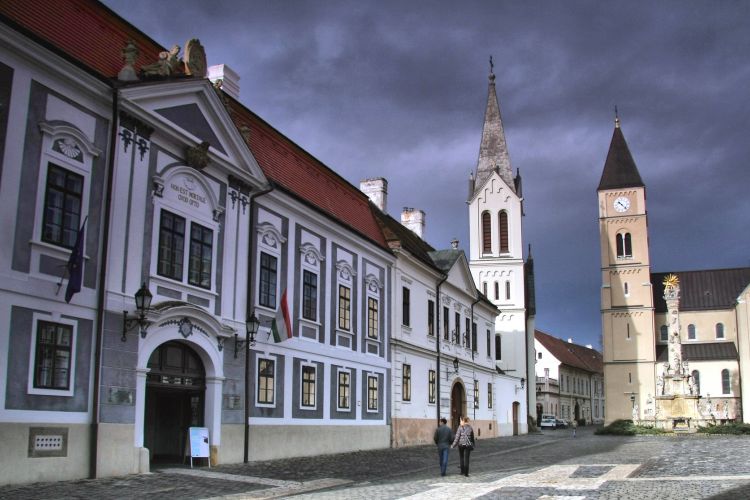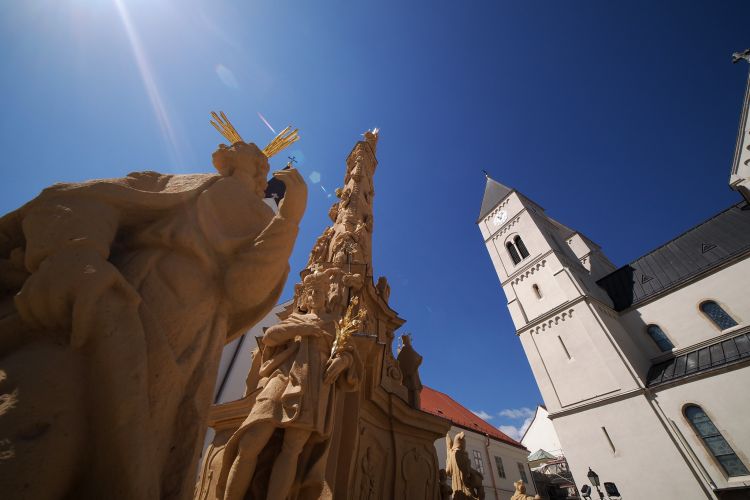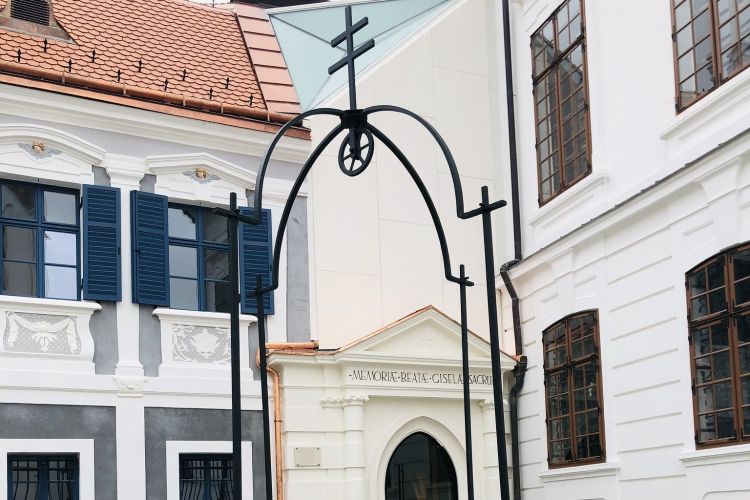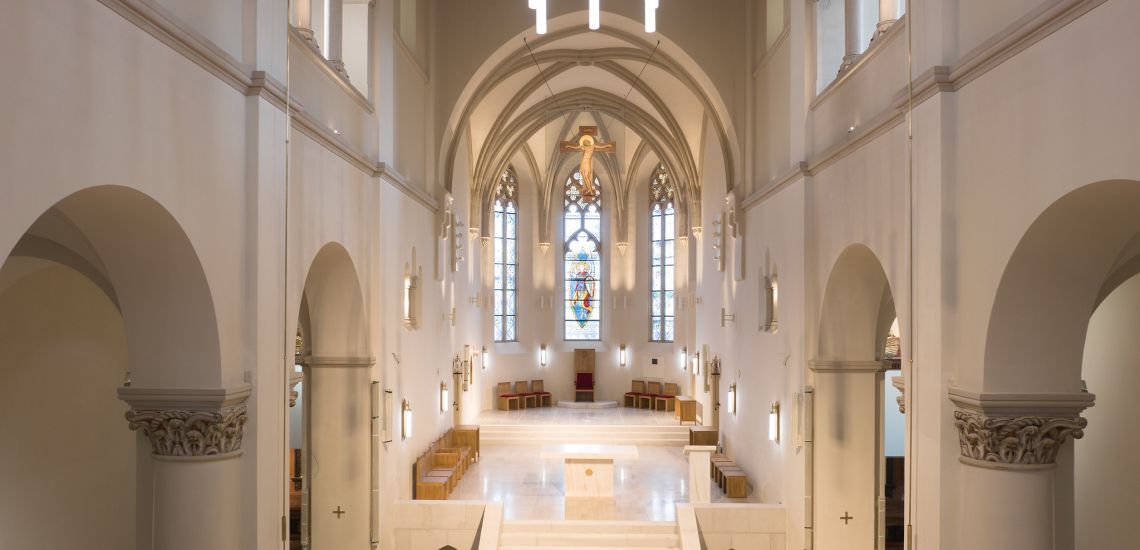
With its three naves and two western towers, Saint Michael's Cathedral on Szentháromság Square is the most prominent building on the castle hill. The Veszprém bishopric was established in the early period of the Hungarian Church, around the year 1000, most probably by King Saint Stephen. Historical sources claim that the construction of the Cathedral was ordered by his wife, Queen Gisela. For a long time, the building also hosted the Queen's throne. In 1981, Pope John Paul II elevated the Cathedral to the rank of basilica minor.
Rising on both sides of the gable, the west facade of the church, with its free-standing towers featuring twin openings, is one of the defining elements of the cityscape. The neo-Romanesque gate was completed in 1909, as attested by a chronogram. The church's thousand-year past is evoked by the carved decoration of the gate arch, which follows the palmetto motifs found on the excavated 11th-century carvings. The sanctuary is an important visual element of the eastern side of the castle hill, as it stands out from the Baroque building complex with its slender neo-Gothic windows framed by buttresses. A large-scale Baroque crypt is located under the main nave of the church. In the past, significant church figures and prominent citizens were buried here.
According to King Stephen's Greater Legend, a document that dates back to the 11th century, the construction of the cathedral commenced by order of Queen Gisela. The current building preserves the remains of this Romanesque church built some time between 1030 and 1040.
In the Middle Ages, the Cathedral had a turbulent history. After being looted and ransacked by the troops of Palatine Péter Csák in 1276, it was destroyed in a fire in 1380. During the restoration following the latter event, the church was expanded to the east. The Gothic sanctuary covered with a ribbed cross vault with long, polygonal closures and buttresses and the eastern part of the crypt dedicated to the Virgin Mary date back to that period. In 1552, the building was heavily damaged during the Turkish siege and again in 1704, when the imperial army rained down artillery fire. The carved stones were then used to restore and construct other buildings in the castle. Starting from 1723, it was restored as a three-nave Baroque church and the earlier extensions were abandoned. In this period, the new vaults of the nave and the surviving main Gothic sanctuary received a rich Baroque painting, presumably by Italian painter Anton Galli Bibiena. Bishop Márton Biró Padányi created a tomb chapel for himself in the space under the south sacristy.
The building assumed its current form between 1907 and 1910 during the transformations carried out in Historicist style according to the plans of Sándor Aigner. At the time, the weakened Baroque vaults and sheathed Romanesque supporting pillars were dismantled, the nave and the transept were rebuilt with a smaller overhang, while the eastern part, which still largely preserved its Gothic forms, was restored with additions. Between 1968 and 1973, the most important phases of the complex construction history of the building were explored by way of historical wall research and archaeological excavation. During the renovation carried out between 1968 and 1978, parts of the uncovered 11th-centruy remains were embedded into the facades of the aisles in the southern vestibule, as well as in the southern corridor and in the first section of the crypt. The interior of the sanctuary was transformed in line with the requirements of liturgical reform.
In 1981, Pope John Paul II elevated the Cathedral to the rank of basilica minor. Since 1996, the building is the home of the bones of Queen Gisela's forearm, which will be transferred to the Gisela Chapel after the latest renovations.
The facade of the cathedral and its roof, which had been leaking for half a century, were renovated between 2005 and 2010.
The Veszprém bishopric was established in the early period of the Hungarian Church, around the year 1000, most probably by King Saint Stephen. Saint Michael is the patron saint of the diocese, based on the patronage of the Cathedral.
The territory of the bishopric included the central part of Transdanubia, between the Danube Bend and the River Drava. About 100 monastic communities functioned in the territory of the diocese until the beginning of the Turkish era.
The history of the diocese can be continuously traced back for over a thousand years, with many outstanding leaders.
In 1981, Pope John Paul II granted the rank of basilica minor to Saint Michael's Cathedral, the largest church in the diocese and in 1993, he elevated Veszprém to the rank of archdiocese.
The Archdiocese of Veszprém has been led by prelate Dr György Udvardy since 2019.
A four-manual liturgical and concert organ was built in the renovated Cathedral with the help of organ expert Dávid Homolya. The Rieger pipes from 1908 that were successfully restored were integrated into the grand organ. Another component that was restored is the original organ cabinet, which has outstanding artistic value and blends in seamlessly with the style of the Cathedral. Proposed future extensions will be also adapted in terms of material, colour and pattern.
The organ has 36 actual registers and weighs a total of 12 tonnes. Of the 2,333 pipes built into the organ, the largest is 5.2 metres in size, while the smallest is only 3.5 millimetres.
The instrument can be played from the organ gallery, as well as from the main nave with the help of a second, mobile playing table.
With the construction of the new organ in St. Michael's Cathedral, Veszprém joined the elite of the organ music scene in both Hungary and Europe.
On 3 April 2023, at the end of the large-scale renovation, a time capsule was placed in the cathedral.
